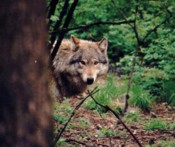 Wolves WolvesWolf History, Conservation, Ecology and Behavior
[www.wolfology.com]
|
Noninvasive Molecular Tracking of Colonizing Wolf (Canis lupus) Packs in the Western Italian Alps
Lucchini, V.; Fabbri, E.; Marucco, F.; Ricci, S.; Boitani, L.; Randi, E., Molecular Ecology, 11/5 (May 2002), 857 (12pp)
We used noninvasive methods to obtain genetic and demographic data on the wolf packs (Canis lupus), which are now recolonizing the Alps, a century after their eradication. DNA samples, extracted from presumed wolf scats collected in the western Italian Alps (Piemonte), were genotyped to determine species and sex by sequencing parts of the mitochondrial DNA (mtDNA) control-region and ZFX/ZFY genes. Individual genotypes were identified by multilocus microsatellite analyses using a multiple tubes polymerase chain reaction (PCR). The performance of the laboratory protocols was affected by the age of samples. The quality of excremental DNA extracts was higher in samples freshly collected on snow in winter than in samples that were older or collected during summer. Preliminary mtDNA screening of all samples allowed species identification and was a good predictor of further PCR performances. Wolf, and not prey, DNA targets were preferentially amplified. Allelic dropout occurred more frequently than false alleles, but the probability of false homozygote determinations was always <0.001. A panel of six to nine microsatellites would allow identification of individual wolf genotypes, also whether related, with a probability of identity of <0.015. Genealogical relationships among individuals could be determined reliably if the number of candidate parents was 6-8, and most of them had been sampled and correctly genotyped. Genetic data indicate that colonizing Alpine wolves originate exclusively from the Italian source population and retain a high proportion of its genetic diversity. Spatial and temporal locations of individual genotypes, and kinship analyses, suggest that two distinct packs of closely related wolves, plus some unrelated individuals, ranged in the study areas. This is in agreement with field observations.
 A Numerical Response of Wolves to Bison Abundance in Wood Buffalo National Park, Canada
Joly, D.; Messier, F., Canadian Journal of Zoology, 78 (June 2000): 1101-1104 (4 pp)
The numerical response of predators to changing prey density is an important component of predator-prey dynamics. We examined factors influencing two indices of wolf (Canis lupus) abundance in Wood Buffalo National Park, Canada: historical wolf pelt harvests from 1970 to 1988 and sightings of wolves by park staff on survey flights from 1973 to 1991. We tested the effect of pelt price (adjusted to 1986-equivalent Canadian dollars), number of trappers, and bison (Bison bison) population size on wolf pelt returns for an 18-year period using a multiple linear regression model. We then tested the relationship between wolf sightings on survey flights and bison population size for an overlapping 19-year period. Wolf pelt price was a significant determinant of wolf harvest, whereas numbers of bison or trappers were not significant predictors of wolf harvest. However, there was a significant relationship between wolf sightings and bison population size. This analysis suggests that wolf population size was correlated with bison numbers, similar to the numerical response seen in other wolf-prey systems.
 Occurrence of Pursuit Deterrence Signals During Wolf Hunts of Elk in Yellowstone National Park: A Preliminary Assessment
MacNulty, D., Beyond 2000: Realities of Global Wolf Restoration (2000)
Numerous studies of gray wolf (Canis lupus) predation involving inspection of carcass remains have fostered the idea that wolves are able to distinguish between vulnerable and invulnerable prey. Evidence from aerial and ground-based observation of wolves hunting suggests that wolves respond to behavioral cues of physical condition or so-called pursuit-deterrent signals in prey. Workers in Africa's Serengeti have found that stotting in Thomson's gazelle (Gazella thomsoni) was an honest signal of a gazelle's ability to outrun wild dogs (Lycaon pictus), which wild dogs took into account when selecting gazelles. Film footage was used to identify and describe pursuit-deterrent signals in elk (Cervus elaphus) being hunted by wolves in Yellowstone National Park. Since wolves are generally limited to killing vulnerable prey they must employ a coursing hunting strategy in order to single out an individual prey animal. To avoid being selected, physically fit elk may advertise their ability to escape by standing off or prancing away from attacking wolves. If standing off and prancing are to be considered pursuit-deterrent signals two conditions must be met. First, performance (i.e. duration) of the signal must be closely linked to physical condition. Second, wolves should select elk on the basis of their standing off or prancing behavior. Both wolves and elk would benefit from pursuit-deterrent signals by avoiding energetically costly pursuits.
|
